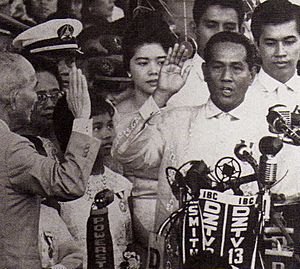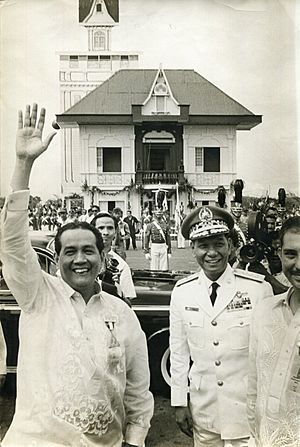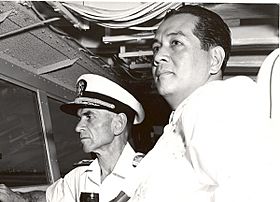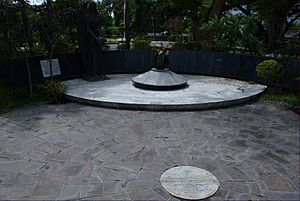Diosdado Macapagal facts for kids
Quick facts for kids
Diosdado P. Macapagal
|
|
|---|---|

Macapagal, c. 1962
|
|
| 9th President of the Philippines | |
| In office December 30, 1961 – December 30, 1965 |
|
| Vice President | Emmanuel Pelaez |
| Preceded by | Carlos P. Garcia |
| Succeeded by | Ferdinand Marcos |
| 2nd President of the 1971 Philippine Constitutional Convention | |
| In office June 14, 1971 – January 17, 1973 |
|
| President | Ferdinand Marcos |
| Preceded by | Carlos P. Garcia |
| Succeeded by | Position abolished |
| 5th Vice President of the Philippines | |
| In office December 30, 1957 – December 30, 1961 |
|
| President | Carlos P. Garcia |
| Preceded by | Carlos P. Garcia |
| Succeeded by | Emmanuel Pelaez |
| Member of the House of Representatives of the Philippines from Pampanga's 1st congressional district | |
| In office December 30, 1949 – December 30, 1957 |
|
| Preceded by | Amado Yuzon |
| Succeeded by | Francisco Nepomuceno |
| Party President of Liberal Party of the Philippines | |
| In office December 30, 1957 – December 30, 1965 |
|
| Preceded by | Eugenio Perez |
| Succeeded by | Cornelio T. Villareal |
| Personal details | |
| Born |
Diosdado Pangan Macapagal
September 28, 1910 Lubao, Pampanga, Philippine Islands |
| Died | April 21, 1997 (aged 86) Makati, Philippines |
| Resting place | Libingan ng mga Bayani, Taguig, Metro Manila, Philippines 14°31′11″N 121°2′39″E / 14.51972°N 121.04417°E |
| Political party | Liberal |
| Spouses |
Purita de la Rosa
(m. 1938; died 1943)Eva Macaraeg
(m. 1946) |
| Children | Ma. Cielo R. Macapagal-Salgado Arturo Macapagal Ma. Gloria M. Macapagal-Arroyo Diosdado M. Macapagal Jr. |
| Alma mater | University of the Philippines University of Santo Tomas |
| Profession | Lawyer Poet professor |
| Signature | |
Diosdado Pangan Macapagal Sr. (born September 28, 1910 – died April 21, 1997) was a Filipino lawyer, poet, and politician. He served as the ninth president of the Philippines from 1961 to 1965. Before that, he was the sixth vice president from 1957 to 1961.
Macapagal also worked as a member of the House of Representatives. He later led the Constitutional Convention of 1970. His daughter, Gloria Macapagal Arroyo, also became president of the Philippines from 2001 to 2010.
People often called him "the poor boy from Lubao." He was born in Lubao, Pampanga. He studied at the University of the Philippines and University of Santo Tomas. After finishing his studies, he worked as a lawyer for the government.
He first won an election in 1949 to become a representative for Pampanga's 1st congressional district. In 1957, he became vice president under President Carlos P. Garcia. He later ran against Garcia and won the presidency in 1961.
As president, Macapagal worked to stop corruption and help the Philippine economy grow. He introduced the country's first land reform law. He also allowed the Philippine peso to be traded freely in the currency market. Many of his plans, however, faced challenges from Congress. He is also known for changing the date of Independence Day from July 4 to June 12. This change honored the day Emilio Aguinaldo declared independence in 1898. He lost his re-election bid in 1965 to Ferdinand Marcos.
After his presidency, Macapagal was chosen to lead the 1970 constitutional convention. This group wrote what became the 1973 Constitution. He passed away in 1997 at 86 years old due to heart and kidney problems. Macapagal was also a respected poet who wrote in Spanish.
Contents
Early Life and Education
Where was Diosdado Macapagal born?
Diosdado Macapagal was born on September 28, 1910, in Lubao, Pampanga. He was the third of five children in a family that was not wealthy. His father, Urbano Macapagal, was a poet who wrote in the local Kapampangan language. His mother was Romana Pangan Macapagal.
His family earned extra money by raising pigs and renting out rooms in their home. Because he grew up in a humble background, Macapagal became known as the "Poor Boy from Lubao."
How did Diosdado Macapagal get his education?
Macapagal was a very good student in public schools. He graduated at the top of his class from Lubao Elementary School. He was also the salutatorian (second highest in class) at Pampanga High School. He started his pre-law course at the University of the Philippines.
In 1932, he enrolled at Philippine Law School with a scholarship. He worked part-time as an accountant to support himself. He was known for being a great speaker and debater in law school. However, he had to stop studying for two years because he got sick and ran out of money.
He later returned to his studies at the University of Santo Tomas. A kind person named Don Honorio Ventura helped pay for his education. His relatives also gave him financial support. In 1936, he earned his law degree and passed the bar exam with one of the highest scores. He continued his studies, earning a Master of Laws degree in 1941 and a Doctor of Civil Law degree in 1947. He also got a PhD in economics in 1957.
What was Diosdado Macapagal's early career like?
After becoming a lawyer, Macapagal worked for an American law firm. This was a special honor for a Filipino at that time. He also worked as a legal assistant for President Manuel L. Quezon. During World War II, he secretly helped the anti-Japanese resistance while working for President Jose P. Laurel.
After the war, he joined the government again. President Manuel Roxas appointed him to the Department of Foreign Affairs. In 1948, President Elpidio Quirino chose Macapagal to lead talks for the transfer of the Turtle Islands from the United Kingdom to the Philippines. This was a success. He then worked at the Philippine Embassy in Washington, D.C.
Who was Diosdado Macapagal married to?
In 1938, Macapagal married Purita de la Rosa. They had two children: Cielo Macapagal-Salgado and Arturo Macapagal. Purita passed away in 1943.
On May 5, 1946, Macapagal married Dr. Evangelina Macaraeg. They had two children: Gloria Macapagal Arroyo, who later became president, and Diosdado Macapagal, Jr.
Serving in the House of Representatives
President Quirino asked Macapagal to run for a seat in the House of Representatives for the 1st district of Pampanga. He won by a large margin in the 1949 election. He was re-elected in 1953. He served in the 2nd and 3rd Congresses.
As a representative, Macapagal became the head of the Committee on Foreign Affairs. He was a delegate to the United Nations General Assembly many times. He helped with important agreements like the U.S.-R.P. Mutual Defense Treaty and the Laurel–Langley Agreement. He also wrote the Foreign Service Act, which improved the Philippine foreign service.
Macapagal also created and supported laws that helped the economy and society. These laws were especially for people in rural areas and those who were poor. Some of these laws included the Minimum Wage Law, Rural Health Law, and the Rural Bank Law. He was often named one of the top congressmen during his time.
Vice Presidency (1957–1961)
In the May 1957 elections, the Liberal Party chose Macapagal to run for vice president. He ran with José Yulo. Even though Yulo lost the presidential race, Macapagal won the vice presidency. He defeated the candidate from the rival Nacionalista Party. A month later, he became the president of the Liberal Party.
Macapagal was the first vice president elected from a different party than the president. The ruling party did not give him a Cabinet position. This was unusual at the time. He refused to switch parties and instead became a critic of the administration's policies. This helped him gain popularity as the Garcia administration became less popular. He spent his time traveling around the country, meeting voters, and promoting his party.
Presidency (1961–1965)
| Presidential styles of Diosdado Macapagal |
|
|---|---|
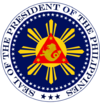 |
|
| Reference style | His Excellency |
| Spoken style | Your Excellency |
| Alternative style | Mr. President |
In the 1961 presidential election, Macapagal ran against President Garcia. He promised to end corruption and presented himself as a common man. He won the election with 55% of the votes. He became president on December 30, 1961.
What were Diosdado Macapagal's domestic policies?
Economy
When he became president, Macapagal promised to focus on "free and private enterprise." This meant he wanted private businesses to lead economic growth with less government control.
Just 20 days after becoming president, he removed currency controls. This allowed the Philippine peso to be traded freely. The peso's value changed from P2.64 to P3.80 against the U.S. dollar. This was supported by a $300 million fund from the International Monetary Fund.
Macapagal believed that economic development should mainly be handled by private businesses, not the government. He signed a Central Bank order to abolish exchange controls and return the country to free enterprise.
Even though many of his reform efforts were blocked by the Nacionalista Party in Congress, Macapagal still achieved steady economic growth. The country's GDP grew by an average of 5.53% each year from 1962 to 1965.
Socio-economic Program
Macapagal's goal was to bring economic and social progress to everyone. He created a Five-Year Socio-Economic Integrated Development Program. This program aimed to:
- Quickly bring back economic stability.
- Help ordinary people.
- Create a strong base for future growth.
He believed the government should help by building things like roads and ports that help the economy. The government should also encourage investments and promote important industries like steel and fertilizers.
Land Reform
Macapagal was known as the "Poor boy from Lubao." One of his important achievements was the Agricultural Land Reform Code of 1963 (Republic Act No. 3844). This law aimed to buy private farmlands and divide them into smaller lots for farmers who did not own land. These farmers could then pay for the land easily.
This law was a big step in the history of land reform in the Philippines. It limited the amount of land a landlord could keep to 75 hectares. It also ended the share-tenancy system, where farmers had to give a share of their crops to landlords. The law also gave agricultural workers the right to organize and earn a minimum wage.
However, the law had some weaknesses. There were many exceptions for certain types of land. Also, landlords were paid in bonds, which they could use to buy other agricultural lands. The government also did not provide enough money to fully implement the law. Because of these issues, the law only helped a small number of farmers.
Anti-Corruption Drive
One of Macapagal's main promises during his campaign was to stop government corruption. His administration also had disagreements with powerful Filipino businessmen.
Independence Day
Macapagal changed the date of Philippine Independence Day. On May 12, 1962, he declared June 12, 1962, as a special public holiday. This day honored the declaration of independence from Spain in 1898. This change became permanent in 1964. Macapagal later explained that he wanted a different holiday date because many people attended American Embassy parties on July 4 instead of Philippine ones.
What were Diosdado Macapagal's foreign policies?
North Borneo Claim
On September 12, 1962, during Macapagal's time as president, the heirs of the Sultanate of Sulu gave the territory of eastern North Borneo (now Sabah) to the Republic of the Philippines. This allowed the Philippine government to pursue its claim over the territory in international courts. The Philippines broke off diplomatic relations with Malaysia when Sabah became part of Malaysia in 1963. This was later restored in 1989. Malaysia continues to reject the Philippines' claim over Sabah.
MAPHILINDO
In July 1963, President Macapagal held a meeting in Manila. He suggested forming a group called Maphilindo for Malaysia, the Philippines, and Indonesia. This idea was meant to bring together the Malay peoples, who were seen as divided by colonial borders.
Maphilindo was meant to be a group where these countries could discuss common issues. However, some saw it as a way for Jakarta and Manila to delay the formation of the Federation of Malaysia. The plan failed when Indonesia's President Sukarno started a "konfrontasi" (confrontation) with Malaysia. Today, the ASEAN group makes it unlikely for Maphilindo to be revived.
Vietnam War
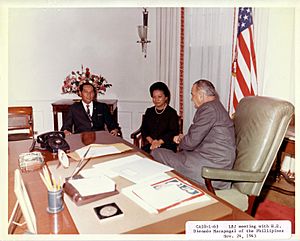
Before his term ended in 1965, President Macapagal tried to get Congress to send troops to South Vietnam. However, this idea was blocked by the opposition, led by Senate President Ferdinand Marcos. Marcos later left Macapagal's Liberal Party and joined the Nacionalista Party.
The United States government wanted other nations to join the war. President Lyndon B. Johnson asked other countries to help South Vietnam in 1964.
1965 Presidential Campaign
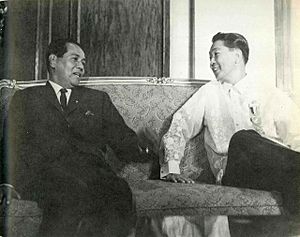
Towards the end of his term, Macapagal decided to run for re-election. He wanted to continue his reforms, which he felt were stopped by a Congress that did not cooperate. Senate President Ferdinand Marcos, who was also a member of the Liberal Party, could not get his party's nomination because Macapagal was running again. So, Marcos switched to the rival Nacionalista Party to run against Macapagal.
Some of the issues raised against Macapagal's administration included corruption, rising prices of goods, and ongoing peace and order problems. Macapagal lost to Marcos in the November 1965 elections.
After the Presidency and Death
After losing the 1965 election, Macapagal announced he was retiring from politics. In 1971, he was chosen to lead the constitutional convention that wrote the 1973 Constitution. However, he later questioned if this constitution was truly legitimate. In 1979, he formed a political party called the National Union for Liberation to oppose the Marcos government.
When democracy was restored in 1986, Macapagal became an elder statesman. He was a member of the Philippine Council of State. He also served as honorary chairman of the National Centennial Commission.
In his retirement, Macapagal spent a lot of time reading and writing. He published his presidential memoir and wrote several books about government and economics. He also wrote a weekly column for the Manila Bulletin newspaper.
Diosdado Macapagal passed away on April 21, 1997, at the age of 86. He died from heart failure, pneumonia, and kidney problems. He was given a state funeral and was buried at the Libingan ng mga Bayani on April 27, 1997.
Legacy
On September 28, 2009, Macapagal's daughter, President Gloria Macapagal Arroyo, opened the President Diosdado Macapagal Museum and Library. It is located in his hometown of Lubao, Pampanga.
President Benigno S. Aquino III declared September 28, 2010, a special non-working holiday in Pampanga. This was to celebrate the 100th anniversary of Macapagal's birth.
Museum and Library
These places hold Macapagal's personal books and important items from his life.
Electoral History
Vice presidential election, 1957:
- Diosdado Macapagal (Liberal Party) – 2,189,197 (46.55%)
- José Laurel Jr. (Nacionalista Party) – 1,783,012 (37.91%)
Presidential election, 1961:
- Diosdado Macapagal (Liberal Party) – 3,554,840 (55%)
- Carlos P. Garcia (Nacionalista Party) – 2,902,996 (45%)
Presidential election, 1965:
- Ferdinand Marcos (Nacionalista Party) – 3,861,324 (51.94%)
- Diosdado Macapagal (Liberal Party) – 3,187,752 (42.88%)
Honors
National Honors
Foreign Honors
 Taiwan:
Taiwan:
 Japan:
Japan:
 Spain:
Spain:
 Knight of the Collar of the Order of Isabella the Catholic (June 30, 1962)
Knight of the Collar of the Order of Isabella the Catholic (June 30, 1962)
 Italy:
Italy:
 Knight Grand Cross with Collar of the Order of Merit of the Italian Republic (July 1962)
Knight Grand Cross with Collar of the Order of Merit of the Italian Republic (July 1962)
 Vatican:
Vatican:
 Pakistan:
Pakistan:
 Recipient of the Nishan-e-Pakistan (July 11, 1962)
Recipient of the Nishan-e-Pakistan (July 11, 1962)
 Sovereign Military Order of Malta:
Sovereign Military Order of Malta:
 Thailand:
Thailand:
 West Germany:
West Germany:
 Grand Cross Special Class of the Order of Merit of the Federal Republic of Germany (November 1963)
Grand Cross Special Class of the Order of Merit of the Federal Republic of Germany (November 1963)
Images for kids
See also
 In Spanish: Diosdado Macapagal para niños
In Spanish: Diosdado Macapagal para niños
- History of the Philippines (1946–1965)
- History of the Philippines
- Gloria Macapagal Arroyo
- Agricultural Land Reform Code
- MAPHILINDO
Named after Diosdado Macapagal:
- Diosdado Macapagal Boulevard
- Macapagal Bridge


